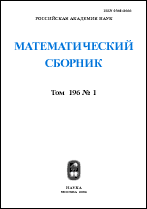|
This article is cited in 13 scientific papers (total in 13 papers)
Convergence of the Rogers–Ramanujan continued fraction
V. I. Buslaev
Steklov Mathematical Institute, Russian Academy of Sciences
Abstract:
Set $q=\exp(2\pi i\tau)$, where $\tau$ is an irrational number,
and let $R_q$ be the radius of holomorphy of the Rogers–Ramanujan function
$$
G_q(z)=1+\sum_{n=1}^\infty z^n\frac{q^{n^2}}{(1-q)\dotsb(1-q^n)}\,.
$$
As is known, $R_q\leqslant 1$ and for each $\alpha\in[0,1]$
there exists $q=q(\alpha)$ such that $R_{q(\alpha)}=\alpha$.
It is proved here that the function $H_q(z)=G_q(z)/G_q(qz)$
is meromorphic not only in the disc $=\{|z|<R_q\}$,
but also in the disc $D=\{|z|<1\}$, which is larger for $R_q<1$; and that the Rogers–Ramanujan continued fraction converges to $H_q$ on compact subsets contained in $D\setminus\Omega_q$, where $\Omega_q$ is the union of circles with centres at $z=0$ and passing through the poles of $H_q$.
The convergence of the Rogers–Ramanujan continued fraction in the domain
$\Bigl\{|z|<\max\bigl(R_q,\frac1{2+|1+q|}\bigr)\Bigr\}\setminus\Omega_q$
was established earlier by Lubinsky.
Received: 02.12.2002
Citation:
V. I. Buslaev, “Convergence of the Rogers–Ramanujan continued fraction”, Sb. Math., 194:6 (2003), 833–856
Linking options:
https://www.mathnet.ru/eng/sm741https://doi.org/10.1070/SM2003v194n06ABEH000741 https://www.mathnet.ru/eng/sm/v194/i6/p43
|


| Statistics & downloads: |
| Abstract page: | 520 | | Russian version PDF: | 255 | | English version PDF: | 10 | | References: | 44 | | First page: | 1 |
|




 Contact us:
Contact us: Terms of Use
Terms of Use
 Registration to the website
Registration to the website Logotypes
Logotypes








 Citation in format
Citation in format 
